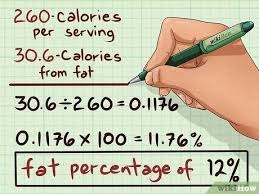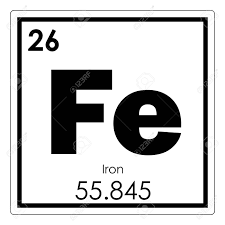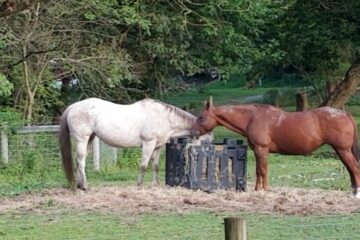Don’t Get Hung Up on Horse Feed Calories

One of the questions I’m frequently asked is how many calories are in a pound of a particular feed. This is a question with an obvious basis for being asked but the answer isn’t as straightforward as one might think.
Most feed companies don’t publish the calories per pound for their horse feed because it can be very misleading if you are counting calories for weight gain or loss.
Let’s take a look at why.
All Calories are Not Digestible
The method used to determine the caloric value of feed and forage is to burn it and measure the heat released. This is why the calorie is a unit of measure of heat released during combustion.
Having a feed that is 50% sawdust will provide a high calorie density but since none of the material in sawdust will be digested by the horse there will be no benefit for weight gain or any nutrition for that matter.
This is the reason that many economy feeds will have a higher caloric density than premium feeds yet the feed rate will be much higher because while the fillers burn hotter during a lab test the ingredients will not be processed by a horse.
Dry Matter Versus As Fed
In the feed world there are two benchmarks to measure the nutrition value of feed and forage.
Dry matter measures the nutrient values of a feed that has had all the moisture removed, “Dry” matter.
As fed measures the nutrient values of the feed as it goes into your horse’s bucket or hay net.
The difference is the moisture in the sample. An “as fed” sample will contain between 10% and 20% moisture. Water weighs 8 pounds per gallon so moisture is a significant consideration in measuring nutrient values.
If one feed company publishes calories per pound based on dry matter and another on as fed there will be a significant difference.
Calories are Processed Differently
A calorie is a set unit of measure and doesn’t vary; however the source of the calorie makes a difference in how much of the energy is stored by the horse.
Fat and carbohydrates contain twice the calories of protein. If you can recall the traditional ratio of protein and fat in horse feeds was about 2:1. Remember 12-6, 10-3, 10-5? It was a way to “balance” energy. This doesn’t mean that these calories have the same impact for energy storage.
If we look at a horse’s body (or ours for that matter) as a factory for the conversion of food to energy, which is the only way to look at it because that’s the fundamental process of life, we must take into account the energy required to process the fuel.
A fossil fuel power plant must use some of the energy derived from the fuel to keep the lights on, run the pumps, keep the office warm, etc. It’s the same with horses.
Protein is much harder to convert to energy than fat and carbs. Significantly harder. Processing fats and carbs requires about 11% energy over resting energy requirements while protein is 30%. One pound of pizza will have more consequences on your waistline than two pounds of lean turkey breast.
The best practical example of this I have found is the difference between Purina Strategy GX and Purina Healthy Edge.
GX contains 1,500 calories per pound while Healthy Edge is 1,300. However, many times I have replaced GX with the same amount of Healthy Edge with no weight loss. The reason is simple.
Strategy GX is 14% protein and 6% fat while Healthy Edge is 12.5% protein and 8% fat. Healthy Edge is also much higher in digestible fiber.
On the other side of the scale GX contains 25% soluble carbohydrates to Healthy Edge’s 16%. I haven’t really sat down to do the math but the results are clear. My experience has been that there is limited to no weight loss when switching to the lower calorie feed.
Forage is the Biggest Source of Calories
On average grass hay provides 800 calories per pound of digestible energy mostly coming from carbohydrates and fiber fermentation. This will vary considerably based on hay type and quality but it’s a good average to use.
Where horses diverge from us in terms of weight gain is their cecum which is the huge fermentation vat that converts quality soluble fiber to volatile fatty acids to store for later.
Before we begin to look for a feed we must ensure that our horse is getting the proper amount of quality forage. If a 1,000 pound horse is getting 20 pounds of grass hay per day it is getting 16,000 calories in digestible energy which, coincidentally is exactly how many calories NRC says that horse needs.
Choose a Feed Based on Performance Requirements
Modern premium feeds have been designed and balanced to meet different performance requirements. If the proper feed is selected for the job at hand there should be little if any fussing with diet.
Strategy GX is designed for horses that are in moderate to heavy work that need a little “snap”. High protein, lower fat and moderate soluble carbohydrates are a great combination for a reining or barrel horse.
I refer to Healthy Edge as a “comatose lesson horse” feed. A nice feed for a horse carrying a beginner to intermediate rider around the ring a couple of times a week.
Ultium competition at 1,900 calories per pound is the feed I move up to when that intermediate rider and horse upgrade to serious work on the show circuit. Protein and fat are almost the same volume but the amino acid profile uses the protein more efficiently.
Calories in ration balancers are almost entirely protein since they contain minimal carbs and fat. Purina Enrich contains 1,500 calories per pound but it doesn’t have the slightest impact on maintaining weight.
Like many things in the horse world the numbers don’t always tell the whole story. It’s not so much about calories as it is about total energy required and the source of that energy.
Carbs are like gasoline for a vehicle, quick energy for short bursts of performance.
Fat is diesel fuel, long distance hauling and good mileage with a slow, steady release.
Protein is the lubricant that keeps the whole thing going.
It’s not that calories in feed don’t matter, of course they do. I am saying that trying to determine which feed is appropriate by trying to reference the published digestible energy of a feed is not very reliable.


